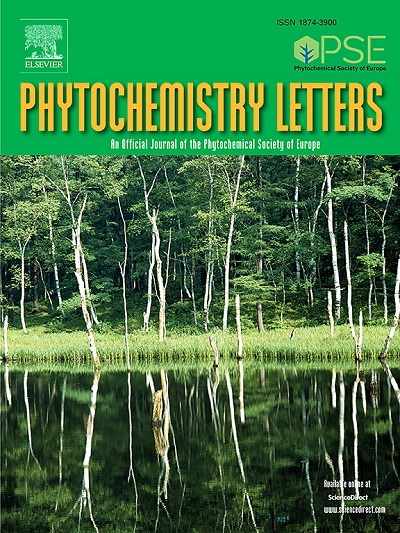Chemical constituents from the stems of Erythropalum scandens
IF 1.4
4区 生物学
Q4 CHEMISTRY, MEDICINAL
引用次数: 0
Abstract
The phytochemical investigation on the EtOH extract of the stems of an ethnological herbal medicine Erythropalum scandens Blume led to the isolation thirteen secondary metabolites. The chemical structures of isolated compounds were elucidated by various spectroscopic techniques. Among them, compound 1, named scandenoside A (1), is a previously unreported aromatic glycoside. Compounds (3-7,9-10,12) were isolated from this plant for the first time. The inhibitory activity of the isolates against xanthine oxidase (XOD) was evaluated, with compound 11 exhibiting strong inhibitory activity and a half inhibitory concentration (IC50) value of 706.35 ± 18.36 µM. Molecular docking analyses revealed that the compound could bind within the active pocket of the XOD enzyme through hydrogen bonding and hydrophobic interactions. These results suggest that the stems of E. scandens may have a potentially beneficial effect on hyperuricemia.
红草茎的化学成分
对民族学中草药红草(Erythropalum scandens Blume)茎叶提取物进行了植物化学研究,分离出13种次生代谢产物。用各种光谱技术对分离化合物的化学结构进行了分析。其中化合物1命名为scandenoside A(1),是一种未被报道的芳香糖苷。化合物(3 ~ 7,9 ~ 10,12)为首次从该植物中分离得到。结果表明,化合物11对黄嘌呤氧化酶(XOD)具有较强的抑制活性,其半抑制浓度(IC50)为706.35 ± 18.36 µM。分子对接分析表明,该化合物可以通过氢键和疏水相互作用结合在XOD酶的活性口袋内。这些结果表明,scandens茎可能对高尿酸血症有潜在的有益作用。
本文章由计算机程序翻译,如有差异,请以英文原文为准。
求助全文
约1分钟内获得全文
求助全文
来源期刊

Phytochemistry Letters
生物-生化与分子生物学
CiteScore
3.00
自引率
11.80%
发文量
190
审稿时长
34 days
期刊介绍:
Phytochemistry Letters invites rapid communications on all aspects of natural product research including:
• Structural elucidation of natural products
• Analytical evaluation of herbal medicines
• Clinical efficacy, safety and pharmacovigilance of herbal medicines
• Natural product biosynthesis
• Natural product synthesis and chemical modification
• Natural product metabolism
• Chemical ecology
• Biotechnology
• Bioassay-guided isolation
• Pharmacognosy
• Pharmacology of natural products
• Metabolomics
• Ethnobotany and traditional usage
• Genetics of natural products
Manuscripts that detail the isolation of just one new compound are not substantial enough to be sent out of review and are out of scope. Furthermore, where pharmacology has been performed on one new compound to increase the amount of novel data, the pharmacology must be substantial and/or related to the medicinal use of the producing organism.
 求助内容:
求助内容: 应助结果提醒方式:
应助结果提醒方式:


